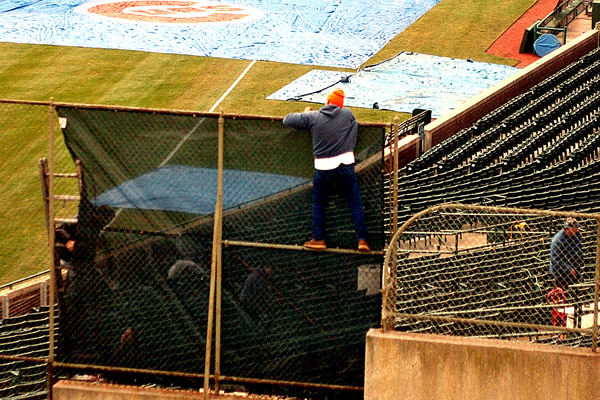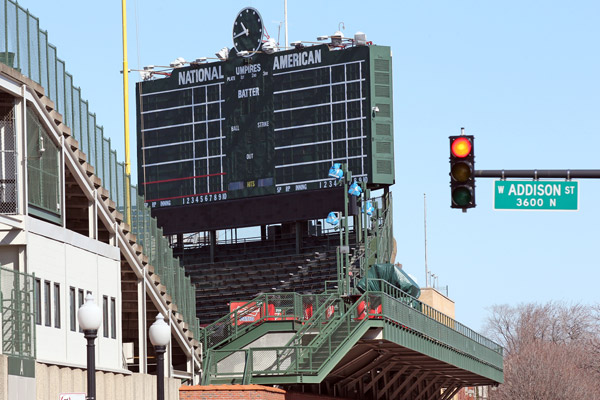It is beginning to look like there's an endgame in the Cubs' negotiations to renovate Wrigley—a comprehensive one involving more night games, cops, and parking, and a jumbotron. The last of these could prove to extend the endgame further:
For the first time, the alderman publicly said he has agreed to allow the team to put up a large video scoreboard in left field despite the objections of rooftop club owners surrounding the stadium. But he cautioned that the size still is being worked out. Tunney also said there’s agreement on another sign in right field.
This has been an issue for years. In 2002, the Cubs put up security (not kidding) screens to block the rooftop owners' views, giving one of baseball's most beloved shrines a touch of A-ball anti-grandeur.

I would have felt more at home, having grown up around a single-A chainlink pit for a baseball stadium, but even those sympathetic to the Cubs in the debate, like John Kass, admitted that "what it cost the Cubs in bad public relations wasn't worth it," and said he would have "cut a deal with the rooftop boys, built a constituency, worked on cross-promotions and won them over."
Which, as it turns out, they did, but not until after the team filed a lawsuit against the rooftop owners. Then, the issue was that the team wanted to expand the bleachers in a race while in a race with the Daley administration, which was pushing landmark status on the building. Both happened—the Cubs got 1,900 seats, Wrigley got landmark status. And in the process, some legal precedent was explored that overshadows the negotiations today, specifically about the jumbotron that is likely to block at least some of the view from the left-field rooftops, which may or may not violate the 20-year agreement between the team and the owners (more on that in a bit).
When the Cubs filed suit against the owners, legal scholars started kicking around the intellectual property laws inherent in the fight, asking whether the owners were on the wrong side of copyright or misappropriation. It's often framed in the context of copyright; take Eric Zorn's reaction back in 2002:
When you watch a ballgame or movie for free on TV, it's on the terms of the business that was selling tickets in the first place. In fact, that business is making extra money on the broadcast. (I hope this doesn't shatter any illusions, but Tribune Co. is not engaged in an act of charity when WGN-TV broadcasts Cubs games. It's engaged in an act of capitalism.) But when you watch a game from a perch above and outside the area where the paying customers are seated, just as when you purchase a bootleg copy of a movie, it's not on the terms of the original ticket sellers. It is, to put it bluntly, theft.
Or Phil Rosenthal, less bluntly, now:
The basic argument, however, still seems a little like when your neighbor with the big-screen TV decides to start watching with the drapes closed on what's become movie night at your house. It's bad form to complain that they not only shouldn't shut the drapes but should open the window and turn up the volume so you and the people in your living room you've charged $1 a head can make out the dialogue better.
Both these arguments rely on the analogy that a baseball game is like a movie. And on an ethical level, you may find that argument convincing; on a legal level, the caselaw (insofar as it exists, there aren't many legal analogs to the Wrigley situation) finds that the two aren't the same.
When the Cubs threw down on the federal lawsuit, UCLA law prof Eugene Volokh looked at the copyright and misappropriation claims, and thought the Cubs would almost certainly lose on the former, on the basis of a 1997 case, National Basketball Association v. Motorola. Basically, Motorola sold $200 "SportsTrax" pagers that displayed "updated information of professional basketball games in progress." (In other words, you got paged the scores. We've come a long way in 16 years.) The NBA said Motorola was stealing its product.
And the circuit court determined that games aren't copyrightable. This is when I love the law, and why I didn't go to law school: when the court, in all its strange majesty, is charged with determining what the nature of a thing is in order to figure out what laws apply to it. It's not often that people get to define something and make it carry the weight of the law, and when it happens we're often treated to charmingly windy discourses (emphasis mine):
In our view, the underlying basketball games do not fall within the subject matter of federal copyright protection because they do not constitute “original works of authorship” under 17 U.S.C. ? 102(a). Section 102(a) lists eight categories of “works of authorship” covered by the act, including such categories as “literary works,” “musical works,” and “dramatic works.” The list does not include athletic events, and, although the list is concededly non-exclusive, such events are neither similar nor analogous to any of the listed categories.
Sports events are not “authored” in any common sense of the word. There is, of course, at least at the professional level, considerable preparation for a game. However, the preparation is as much an expression of hope or faith as a determination of what will actually happen. Unlike movies, plays, television programs, or operas, athletic events are competitive and have no underlying script. Preparation may even cause mistakes to succeed, like the broken play in football that gains yardage because the opposition could not expect it. Athletic events may also result in wholly unanticipated occurrences, the most notable recent event being in a championship baseball game in which interference with a fly ball caused an umpire to signal erroneously a home run.
And you can't copyright hope or faith. (You can copyright a broadcast of hope or faith, because it's a fixed medium with forms of authorship, and so the Cubs could pursue a legal fight against rooftop owners with more than one television—the "dentist's office exception"—and no license to show the broadcasts, should any exist, but for obvious reasons that would be kind of silly.)
Volokh did suggest that you might be able to protect particularly costly forms of hope or faith from misappropriation, but "in Illinois the boundaries of the tort haven't been well-defined," which would mean doing so would be expensive:
The general principle is that courts must consider whether “the plaintiff’s pecuniary reward for producing its intangible product would be severely reduced if other competitors could avoid production costs” by merely free-riding on the plaintiff’s work, but at the same time keep in mind “that freedom to imitate and duplicate is vital to our free market economy.” Board of Trade of City of Chicago v. Dow Jones & Co., Inc., 456 N.E.2d 84 (Ill. 1983). But naturally, these considerations are almost always in tension with each other. In this case, neither factor is very strong: The building owners’ actions aren’t likely to dramatically undermine the Cubs’ revenue, so the plaintiffs’ misappropriation case isn’t that strong; but the building owners aren’t really being that creative in their imitation and duplication, either, so the defendants’ defense isn’t that strong, either.
Which brings us back to the present day. With the windscreens, the Cubs would have simply destroyed revenue, giving them a weak or nonexistent tort case—essentially, the only revenues being undermined would be from people who chose to see the games from the rooftops instead of in Wrigley. Now the contention is stronger: that they're being denied revenue from an inability to put up a screen or signage.
But in the meantime, Wrigley was granted landmark status, and the team signed the agreement with the rooftop owners. So while their tort case might be stronger, the barriers are stronger as well. The Cubs won a smaller victory in 2010 to erect the Toyota advertisment amidst the ordinance-protected "generally uninterrupted sweep of the bleachers," but that was for a 360-square-foot sign; the Landmarks Commission "concluded that, from most vantage points outside the park, the Toyota sign would either not be visible or blend into the scoreboard or grandstands." Even with the Toyota sign, it's still "generally" uninterrupted.
Now the Cubs reportedly want a 6,000-square-foot screen (which could be a negotiating position, but is also of moderate size as stadium jumbotrons go). That would be three times the size of the famous centerfield scoreboard, which wouldn't exactly blend into the grandstands and would set a high bar for the "generally" in "generally uninterrupted."
They do seem to have a loosening of reflexive traditionalism in their favor, the sort of traditionalism that kept the field unlit for so long, but the landmark ordinance isn't just about Wrigley; in 2008, Blair Kamin warned that special consideration to the Cubs would let loose a wave of special pleading for the loosening of other landmark statuses throughout the city. Kamin, who famously hated the divisive Soldier Field englassening ("Klingon meets Parthenon"), contrasted that with the conservative approach to Wrigley necessitated by its landmark status:
The Cubs have been able to make numerous changes, especially the sensitively designed 2006 expansion that gave the ballpark 1,790 more bleacher seats. The expansion turned out as well as it did because landmark status guaranteed a careful review from the city landmarks staff, not just a rubber-stamp from the development-happy City Council.
And then there's the 20-year contract with the rooftop owners. Rosenthal reported that "the contract allows that 'any expansion of Wrigley Field approved by governmental authorities shall not be a violation' of the deal." IANAL, but outside of its context it's hard to tell what that would do to whose odds—whether "expansion" could be tightly read, or whether the owners are indeed putting their trust in the Landmarks Commission and City Council, which worked out for them with the bleachers. It's unlikely to obviate a lawsuit; the Rooftops Association said in a statement today that "any construction that interrupts the Rooftop views will effectually drive them out of business and be challenged in a court of law."
Right now the Cubs' relationship with the rooftop owners is getting all the attention. What happens with that will happen—if it's an agreement, sooner, if not, it's likely to continue in a courtroom. As or more interesting will be the public reaction if something dramatic is poised to happen, like the installation of a 6,000 square-foot jumbotron. Once that's separated from the always-contentious rooftops issue—if that happens—it'll just be the past versus the future and Chicagoans' relationship with their beloved stadium.
What people will think I don't have a read on, but in 2010 Paul Sullivan polled the Cubs: not the management, but the players themselves about their workplace. It's a small sample size, but they were divided. Jeff Samardzija suggested sticking it on the roof with the Horseshoe Casino sign, "that way it's not even in the field… nothing gaudy like Yankee Stadium, where the Jumbotron is as big as the whole stadium." (It's really big.) Tom Gorzelanny and Aramis Ramirez were pro-jumbotron.
One player held out as stubbornly, scrappily anti-jumbotron, anywhere, in any form.
"If you're going to do that, you might as well change the whole park and modernize everything…. The way it is now is the way it's been for years, and the way it's meant to be, so you might as well leave it the way it is. I know things change and times change, but from a historical standpoint, that Wrigley vibe, that feel … a Jumbotron would change everything."
Do I even have to tell you it was Ryan Theriot?



